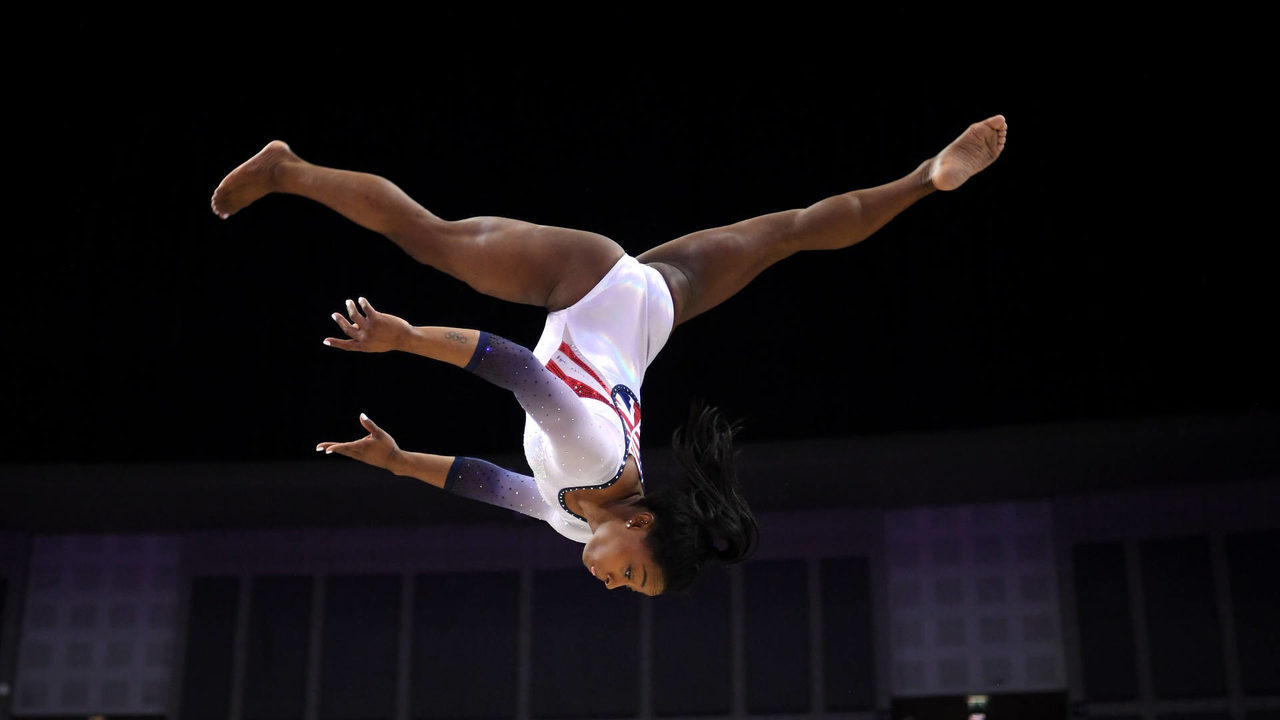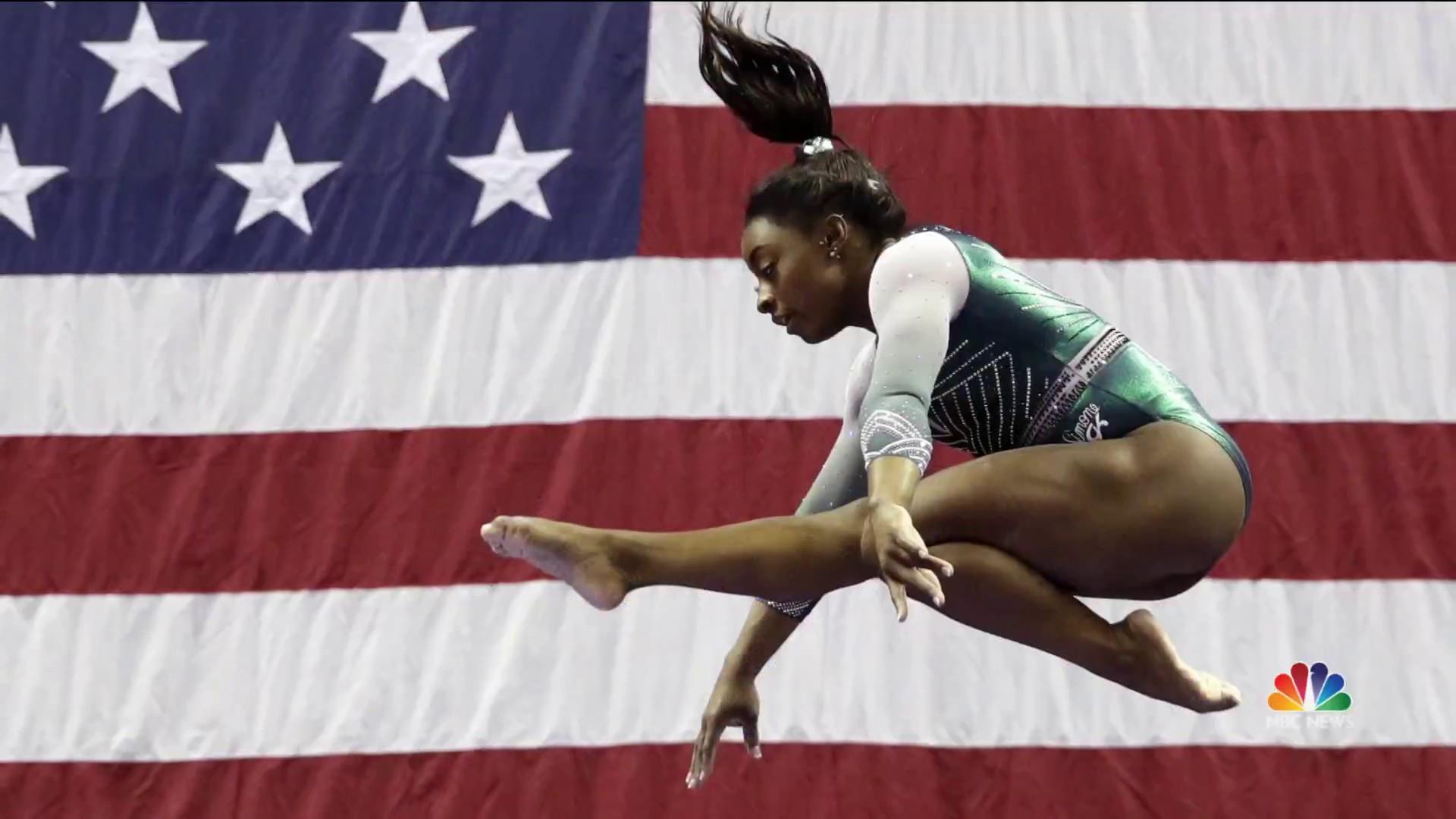

The GOAT continues to revolutionize the sport on and off the mat.
After an uncharacteristic error on floor exercise during the first night of the U.S. Gymnastics Championships in Kansas City this past Friday, Simone Biles saluted the judges, left the podium, and proclaimed: “I’m just pissed off already.” NBC’s perennially excitable gymnastics commentator, Tim Dagget, concurred, informing viewers that this was unequivocally the worst meet he’d ever seen Biles complete. (She later referred to her own perfectly decent bar routine as a “piece of shit” on live television, forever cementing herself as my simultaneous swearing and gymnastics hero.)
Still, there’s no denying that Biles—who recently wore an actual bedazzled goat head on the back of her leotard in a training session—remains the greatest of all time. Yes, it’s been established that she is eons better than all of the women and most of the men in the world of elite gymnastics. But what casual fans may not realize is that her greatness goes beyond her medal count and margins of victory. Biles has pushed the sport to places where it’s never dared go, and even after she retires, there will be no unringing that particular bell.

Biles’ only competition is herself, and so even on that alleged worst and most horrendous trash garbaggio night of her life, she still ended in first place by almost 2 full points, once again leaving the deepest and best women’s gymnastics field in the world in the dust. Athletes’ scores from both nights were totaled to determine their final standings, and after a markedly better second night on Sunday, Biles also ended up winning the whole competition by 4.95, meaning that she could have counted four more falls and still claimed her sixth national title.
And in case that dominant margin of victory were not enough triumph for one competition, Biles also—as her last act on Day 1—destroyed a new balance beam dismount, the most difficult and daring in the history of the sport: a double-double, or a double somersault with a full twist in each flip. This is a skill that is usually reserved for the floor exercise—an apparatus that is 40 feet wide and outfitted with 11 centimeters of springs. Biles did it off the end of a lightly padded plank 4 inches wide and 4 feet off the ground, and she made it look easy.
When she competes this skill at the 2019 World Championships in Germany this October, it will be named after her—the third such skill in the sport’s Code of Points.
Well, actually it will be the fourth.
Because, oh yeah: In Biles’ floor routine on that first night—the one that made her so mad she didn’t want to complete the meet—Biles threw (and made a mistake on the landing of) the single most spectacular skill that any female gymnast has ever attempted, on any apparatus, in the history of the sport. Its astronomical difficulty rating is why Biles earned the top score of the evening despite her self-flagellating. This is a move that will clearly also need to be added to the Women’s Code of Points, as it is currently so difficult that only a small handful of the world’s very best male gymnasts can do it. (Number of men in the U.S.? Zero.) It was also a skill that a singularly determined Biles came back to and obliterated on Day 2, eradicating any doubt as to whether there are enough bedazzled goat heads in the world to express just how good she is (there are not):
Ladies, gentlemen, and friends beyond the binary, allow me to introduce you to the tripledouble: a double back somersault with three twists spread out over the two flips. In men’s gymnastics, it’s called the Ri Jong Song, after the North Korean who debuted it at the 2004 Olympics in Athens. Among the few male elites who can land this monster is none other than legendary Japanese twister Kenzo Shirai (who can also, impossibly, do it in the layout position). It’s also been competed by gymnastics’ king, 21-time world medalist Kohei Uchimura—who a few weeks ago gushed in Japanese on Twitter about Biles’ technique. Since Biles already has a floor element named in her honor, when she completes the triple double in Stuttgart, in the Women’s Code of Points it will be christened the Biles II. (If you are eager for it, and why wouldn’t you be, there’s a super-slo-mo video.)
Simone Biles, when she finally does hang up the grips for good, will have changed the gymnastics alphabet, which ranks all skills in the Women’s Code of Points on a letter scale beginning with A (easy elements such as cartwheels), and going all the way up to I. There are only a handful of “I” skills, including the Moors, a double-double in the layout position on floor. This quadrennium, the Code of Points for Women’s Artistic Gymnastics stops at I. And yet, the future Biles II is more difficult than the Moors; as such, if it has an ounce of sense, the WTC will have to lift the cap in Stuttgart and value the Biles II an unprecedented J—raising the upper limits of gymnastics once again. By the time Biles retires, I wouldn’t be surprised if they’ve run out of letters.
Biles has also changed how other gymnasts approach the floor exercise, both in and out of the U.S. This was the case even in 2016, when Aly Raisman—famous for a tumbling pass most people said couldn’t be done—added yet more difficulty just to remain competitive with Biles, and it holds even truer now. Both Jade Carey and MyKayla Skinnercurrently compete floor routines that just a few years ago would have been unthinkably difficult—and according to Inside Gymnastics, are training triple doubles themselves. (I’ll believe it when I see it!) International competitors—such as Canada’s Brooklyn Moors, Russia’s Angelina Melnikova, and Japan’s Mai Murakami—have all pushed the difficulty of their floor routines just to have a chance at the podium.

Even five years ago, the women’s double-double was a relative rarity, a show-stopper reserved for the best of the best. Now, it’s a de facto requirement for any serious floor worker. (All elites at Biles’ gym, the World Champions Centre, are currently training the skill.) By introducing the triple double, Biles has again raised the standards of women’s floor exercise to such an extent that even though nobody can catch her, anyone who wants onto the podium beside her must absolutely go for broke.
And finally, there’s the small matter of the fearless humanity Biles displays as not just a gymnast, but a celebrity. In short, she’s changed the standard for how gymnasts are “supposed” to act off the mat. Whether she’s displaying open disappointment on television (even, gasp, cursing!) or calling out USA Gymnastics to remind us, through defiant tears, that the organization “had one job” and failed at it, she’s exposed the lie of the stereotype that pegs gymnasts as meek, obedient princesses. When she’s wearing the GOAT leotard, Instagramming herself at the beach or out on the town, or canoodling with her boyfriend of two years, she’s defying the thought that this elite level of the sport requires a punishing seriousness.
She’s a far cry from the frightened, docile, near-silent ghost of gymnasts past—the girls who, no matter what happened or who did what to them, were expected to look blankly into the camera and chirp, I just want to go out there and hit all my routines. Revolutionizing the Code of Points may have changed the way gymnasts train and compete, but in being her unapologetic self, Simone Biles has also blazed the trail for a new generation of gymnasts to speak up for themselves without fear.
Even after Biles someday retires, the changed landscape of the sport will remain. Years from now, some little girl just learning a cartwheel somewhere will know, unequivocally, that a triple double is possible—and that so is being a world-class gymnast and a real, complex person at the same time. There are many reasons I do not wish to be a human American woman in 2019. But what a privilege it is to simply coexist during the era of Simone Biles.










